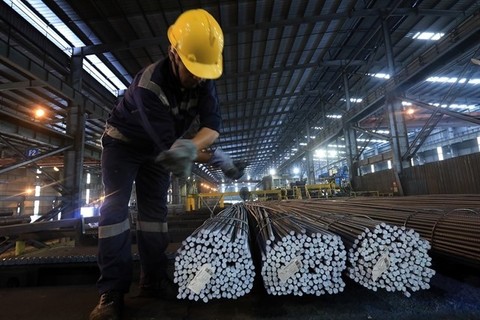
Hoà Phát's teel products. The total market demand for Việt Nam's manufacturing industries by 2030 could reach US$310 billion. — VNA/VNS Photo
Việt Nam plans to develop green and energy-saving steel products and increase the market share of domestically produced steel to gradually replace imported products.
Those goals are stated in the draft of the strategy on developing Việt Nam's steel industry until 2030, with a vision to 2050, which the Ministry of Industry and Trade has developed to submit to the Government for approval.
This strategy is expected to be approved in September.
It will guide State agencies and localities to build mechanisms, policies and to manage the development of the domestic steel industry.
The strategy will help enterprises of the steel industry develop their long-term and short-term business development plans in harmony with the development of the industry and product development strategies.
It will also give directions in production technology and the development of raw materials for the steel industry.
Việt Nam now ranks 12th in the world regarding crude steel production, but the Vietnamese steel industry has limitations in terms of technology, raw materials, production capacity and product types.
The goals set out in the drafted Steel Industry Development Strategy until 2030, with a vision to 2050 developed by the Ministry of Industry and Trade, are to overcome these limitations and promote the modern and sustainable development of the steel industry.
Deputy Director of the Department of Industry, Ministry of Industry and Trade Nguyễn Ngọc Thành said that Việt Nam needs policies to develop the metallurgy and materials industry, especially steel for the processing and manufacturing industry.
Specifically, developing more large-scale iron and steel complexes with diverse product structures, especially steel products, is necessary for the processing and manufacturing industry. It will focus on encouraging the production of alloy steel, especially for the mechanical and machine manufacturing industries.
Việt Nam also needs to develop the steel industry strategy in the direction of attracting investment in large steel complexes to produce a variety of steel products, especially steel used in the processing, manufacturing, mechanical and automotive industries.
According to preliminary forecasts, the total market demand for Việt Nam's manufacturing industries by 2030 could reach US$310 billion. Of which, mechanical engineering for industrial works would account for $120 billion, for construction, agriculture and processing, $15 billion, for standard equipment, $10 billion, railway transport $35 billion, subway $10 billion and cars $120 billion.
This will be a significant market for the domestic steel industry, especially for high-quality fabricated and alloy steel products for the manufacturing industry, a segment in which Việt Nam is not self-sufficient in domestic steel production now.
However, most of them are small-scale with a capacity of under 500,000 tonnes each year and outdated technology and they consume a lot of energy, so they have low competitiveness and cause environmental pollution.
Today, the industry has a tiny number of recently established steel complexes with closed technology, such as Hưng Nghiệp Fomosa and Dung Quất steel complexes.
In addition, this industry still depends on imported raw materials, which means it is tied to fluctuations in global prices.
Meanwhile, production capacity and product variety are still limited. The structure of raw materials for production includes 42 per cent from scrap steel (mainly imported) and 58 per cent from iron ore. Hot-roiled coil (HRC) steel manufacturers can produce only eight million tonnes each year, while domestic demand is at ten million tonnes.
Due to capacity constraints, outdated equipment, high energy consumption, and environmental risks, the quality of domestically produced steel products, especially fabricated steel, is not higher than that of imports, so the competitiveness of the Vietnamese steel industry is still quite low. Domestic enterprises mainly compete with each other, while exports are still at a small volume.
Việt Nam's finished steel production is projected to hit 30 million tonnes this year, marking a seven per cent annual increase, according to the Ministry of Industry and Trade (MoIT).
In the past seven months, finished steel production reached nearly 17 million tonnes, up 9.4 per cent yearly. Coated and colour-coated steel led the growth with a 29.2 per cent surge, followed by construction steel (14.6 per cent) and hot-rolled coil (HRC) (2.9 per cent). Finished steel consumption also climbed by 14.3 per cent, reaching 16.75 million tonnes.
Steel exports totalled nearly 4.9 million tonnes, marking a 6.8 per cent increase. Cold-rolled coils (CRC) saw the highest growth at 40.6 per cent, followed by coated and colour-coated steel and construction steel. However, exports of steel pipes and HRC declined by 1.2 per cent and 0.8 per cent, respectively. — VNS